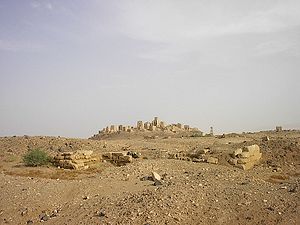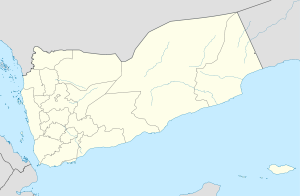- Ma'rib
-
Main article: Ancient history of Yemen"Mareb" redirects here. For the river in Ethiopia, see Mareb River."Mariba" redirects here. For the small town in the United States, see Mariba, Kentucky.
Ma'rib The ruins of Old Ma'rib, which lies to the south of the modern city Location in Yemen Coordinates: 15°25′N 45°21′E / 15.417°N 45.35°ECoordinates: 15°25′N 45°21′E / 15.417°N 45.35°E Country  Yemen
YemenGovernorate Ma'rib Governorate Population (2005) - Ethnicities Arab 16,794 Time zone Yemen Standard Time (UTC+3) Ma'rib (Arabic: مأرب) or Marib is the capital town of the Ma'rib Governorate, Yemen and was the capital of the Sabaean kingdom, which some scholars believe to be the ancient Sheba of biblical fame.[1] It is located at 15°25′0″N 45°21′0″E / 15.416667°N 45.35°E, approximately 120 kilometers east of Yemen's modern capital, Sana'a. It has a current population of 16,794.
Contents
History
Main article: SabaeansThe Sabaean kingdom was located in what is now Marib in southwestern Yemen. The Sabaean kings made their capital at Ma'rib, and built great irrigation works such as the Ma'rib dams, whose ruins are still visible. The Marib Dam supported a flourishing culture for more than a thousand years; its collapse in 575 C.E., a few years after the birth of Muhammad, may be one of the main reasons that Arabia did not become Christian.[2] They also built castles and temples in the area, and were known for trading the valuable frankincense[1] and myrrh.[3] They were a seafaring people and known to have influence and a population in the Northeast African kingdom of Dʿmt, across the Red Sea in Eritrea and perhaps Ethiopia, the only other source of both frankincense and myrrh.
In 25 B.C., Aelius Gallus led "an expedition to Ma'rib (Yemen)."[4]
The site of Ancient Ma'rib was largely abandoned during the 20th century. Although a small village remains, the multi-story mud-brick buildings of the historic city are largely in ruins. The modern city of Ma'rib is located about 3.5 kilometers north of the center of the ancient city.
Oil Refinery
The Yemen Oil Refining Company opened an oil refinery in Ma'rib in 1986, which produces 10,000 barrels (1,600 m3) of oil per day (2009). In November 2009, the company announced an agreement with Korea's Shinhan to expand and upgrade the refinery to produce 25,000 barrels (4,000 m3)/day.[5]
Ma'rib is the start of the 438 km (272 mi) Marib-Ra's Isa oil pipeline, with a capacity of 200,000 barrels (32,000 m3) per day.[6]
Notes
- ^ a b "Saba / Sa'abia / Sheba". The History Files (http://www.historyfiles.co.uk). http://www.historyfiles.co.uk/KingListsMiddEast/ArabicSaba.htm. Retrieved 2008-06-27. "The kingdom of Saba is known to have existed in the region of Yemen. By 1000 BC caravan trains of camels journeyed from Oman in south-east Arabia to the Mediterranean. As the camel drivers passed through the deserts of Yemen, experts believe that many of them would have called in at Ma'rib. Dating from at least 1050 BC, and now barren and dry, Ma'rib was then a lush oasis teeming with palm trees and exotic plants. Ideally placed, it was situated on the trade routes and with a unique dam of vast proportions. It was also one of only two main sources of frankincense (the other being East Africa), so Saba had a virtual monopoly. Ma'rib's wealth accumulated to such an extent that the city became a byword for riches beyond belief throughout the Arab world. Its people, the Sabeans - a group whose name bears the same etymological root as Saba - lived in South Arabia between the tenth and sixth centuries BC. Their main temple - Mahram Bilqis, or temple of the moon god (situated about three miles (5 km) from the capital city of Ma'rib) - was so famous that it remained sacred even after the collapse of the Sabean civilisation in the sixth century BC - caused by the rerouting of the spice trail. By the that point the dam, now in a poor state of repair, was finally breached. The irrigation system was lost, the people abandoned the site within a year or so, and the temple fell into disrepair and was eventually covered by sand. Saba was known by the Hebrews as Sheba. [Note that the collapse of the dam was actually in 575 C.E., as shown in the timeline in the same article in the History Files, and attested by MacCulloch (2009).]"
- ^ Christianity, p.245
- ^ Age of Faith, p. 156
- ^ Chris Scarre, The Penguin Historical Atlas of Ancient Rome (London: Penguin Books, 1995), 9. (also Augustus' Res Getae 26)
- ^ "الشركة اليمنية لتكرير النفط توقع اتفاقا مع شركة شينهان الكورية الجنوبية لتوسعة وتحديث مصفاة مأرب". CNBC عربية. http://www.cnbcarabia.com/cnbc-portal/web/guest/energy?p_p_id=MarketSectorsArticle_INSTANCE_PXTE&p_p_lifecycle=0&p_p_state=maximized&p_p_mode=view&_MarketSectorsArticle_INSTANCE_PXTE_struts_action=%2Fext%2Fmarketsectors%2Fdetails&_MarketSectorsArticle_INSTANCE_PXTE_com.cnbcarabia.article.id=291791&_MarketSectorsArticle_INSTANCE_PXTE_article-type=4. Retrieved 2011-04-05.
- ^ "Middle East Pipelines map - Crude Oil (petroleum) pipelines - Natural Gas pipelines - Products pipelines". Theodora.com/pipelines. http://www.theodora.com/pipelines/middle_east_oil_gas_products_pipelines_map.html. Retrieved 2011-04-06.
See also
References
- Durant, Will (1950). The Age of Faith: A History of Medieval Civilization -- Christian, Islamic, and Judaic -- from Constantine to Dante: A.D. 325-1300, The Story of Civilization, volume IV. Simon and Schuster.
- Korotayev, Andrey (1994). Apologia for "The Sabaean Cultural-Political Area" // Bulletin of the School of Oriental and African Studies 57: 469-474.
- MacCulloch, Diarmaid (2009). Christianity: the First Three Thousand Years, Viking Penguin.
External links
 Ma'rib Governorate
Ma'rib GovernorateCapital: Ma'rib Districts Al Abdiyah District • Al Jubah District • Bidbadah District • Harib District • Harib Al Qaramish District • Jabal Murad District • Mahliyah District • Majzar District • Marib District • Marib City District • Medghal District • Raghwan District • Rahabah District • Sirwah DistrictCategories:- Populated places in Ma'rib Governorate
- Archaeological sites in Yemen
- Former populated places in Southwest Asia
- Districts of Yemen
Wikimedia Foundation. 2010.


